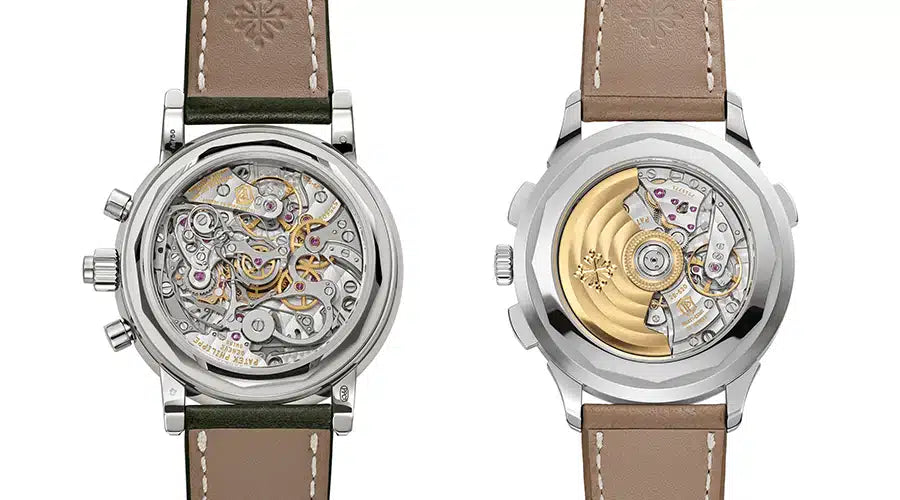
Types of Watches Mechanism
Share
Watches are one of the most fundamental tools created by humans for measuring and keeping track of time. While the first watches in history were known as sundials and water clocks, watches today have advanced significantly and there are many different types available.
What are the basic components of a watch?
The basic components of a watch are its case, dial, movement, hands, and strap. The case and dial of the watch are customized with numbers and markings to help track movements inside as the watch runs. The hands of the watch are the components used to control and adjust watch movements. The watch strap can be made of various materials like leather, stainless steel, nylon and is attached to the components of the watch.What are the types of watches?
Watches are generally divided into two categories: mechanical and quartz watches. In mechanical watches, a spring mechanism is used to operate the watch movements, while quartz watches use batteries as the energy source. Mechanical watches can be divided into three categories: automatic, manual, and chronograph watches. Automatic watches generate energy with a personal winding mechanism as the user moves their wrist, manual watches are wound by turning the crown, and chronograph watches have an additional stopwatch function to measure watch movements.
What materials are used to make watches?
Most watch cases are made of metal, ceramic, or plastic materials. Stainless steel and titanium are commonly used materials. Watch straps can be made of many different materials. Leather, fabric, stainless steel, rubber, silicone, and luxurious alligator leather straps are just a few examples of available options.
What are the additional functional features in watches?
The category of additional functions in watches is quite extensive. There are many features such as water resistance, chronometer function, date display, alarm function, calendar function, compass function, among many others. Additionally, some watches can be highly personalized and are available in different colors and styles.
What should we pay attention to when choosing a watch?
When choosing a watch, style, reasonable price, accuracy, and many other features can be considered. To choose a good watch, research and reviews about various products can be helpful. Also, before purchasing a watch, it’s important to determine the purpose for which the watch will be used. It’s possible to choose different watches with diverse features for activities such as sports, daily use, or special events.
Importance and popularity of watches as a timekeeping tool and fashion accessory
The Importance of Clocks as a Timekeeping Tool
Clocks have become an important tool for meeting and tracking people's time measurement needs. Proper tracking of time helps individuals to manage their appointments, work, and daily lives more easily. Effective time management is crucial in the business world, society, and personal life, and clocks play a major role in this.
The use of clocks helps people to use their time more efficiently. Clocks assist in completing tasks that need to be accomplished throughout the day within a specific time frame, setting time accurately, and keeping up with schedules. Additionally, clocks are indispensable in the business world for attending meetings on time, completing tasks, and facilitating tracking.
Clocks also provide reliability in measuring and tracking time. With their mechanical or quartz-based features, clocks display hours, minutes, and seconds precisely. This allows people to rely on time when making their moves. For example, relying on clocks is important to arrive at the airport on time to catch a flight or to be ready for a meeting.
The Popularity of Clocks as Fashion Accessories
Clocks have gained popularity not only as a timekeeping tool but also as an important accessory in the fashion world. For many people, watches are valued as a means of expressing their style, taste, and personality. Fashion brands in the industry manufacture watches in various styles, colors, and materials.
The popularity of clocks as fashion accessories has increased with many people incorporating watches into their daily lives as if they were jewelry. Luxury watch brands particularly produce watches designed with eye-catching features such as precious metals, diamonds, and other valuable gemstones. These watches are preferred to emphasize elegance and prestige at special events and social gatherings, becoming a part of people's daily lives.
Furthermore, another reason for the popularity of clocks as fashion accessories is the ability to personalize them. Many brands offer different case, dial, and strap styles, allowing users to choose watches that fit their own style. This transforms watches from just timekeeping tools to fashion statements.
In conclusion, clocks are of great importance both as a timekeeping tool and as a fashion accessory. Their contribution to effective time management and their use as a means of expressing style and personality have made them an indispensable tool. With the evolving fashion trends and technological advancements, the importance and popularity of clocks will continue to grow.

Evolution of watches over time and technological advancement
The Passage of Time: Changes in Clocks over Time and Technological Advances
Measuring and keeping track of time has been an important requirement for humanity for centuries. Clocks have been used to meet this need, but the evolution of clocks over time and technological advancements have allowed people to manage time more accurately and effectively. In this article, we will examine how clocks have changed over time and how technological advancements have affected them.
Sundial: The earliest form of clocks in prehistoric times were sundials. The oldest examples of these clocks, which measured time by the movement of the sun in the sky, date back to the civilizations of Egypt and Mesopotamia. However, sundials were limited practically, as they were dependent on natural light and weather conditions.
Mechanical Clocks: Mechanical clocks emerged after sundials. Mechanical clocks functioned by using springs and gear mechanisms. The clock towers, cathedrals, and other large structures on which these clocks were mounted were early examples of mechanical clocks. People began to measure and keep track of time more accurately with the advent of mechanical clocks.
Pocket Watch: Alongside the development of mechanical clocks, pocket watches were invented for people who needed mobility. Many people realized the advantage of having portable watches that they could carry in their pockets or bags. Pocket watches were smaller and more portable versions of mechanical clocks.
Quartz Clocks: Technological advancements brought about a major change in the clock industry. The invention of quartz clocks in the early 20th century revolutionized the clock industry. Quartz clocks operate with the piezoelectric effect and make more accurate time measurements. This innovation made clocks more accurate, durable, and requiring less maintenance.
Digital Clocks: Digital clocks emerged with the development of electronic and digital technology. Digital clocks display time using numerical displays and electronic circuits. These clocks are more functional than analog clocks and have become popular due to their ease of readability.
Smart Watches: Technological advancements in recent years have enabled clocks to take one step further and led to the birth of smartwatches. Smartwatches are watches that combine various functions and can interact with connected devices. These watches offer users a wide range of experiences, such as health tracking, communication, and music listening.
The evolution of clocks over time has helped us measure time more accurately and manage it effectively. Technological advancements have made clocks more functional, portable, and user-friendly. More innovations and advancements are expected in clocks in the future.
